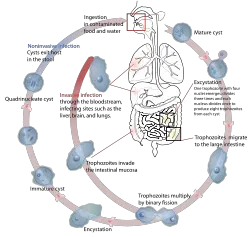Dysentery
Dysentery (formerly known as flux or the bloody flux) is an infection of the digestive system that results in severe diarrhea containing mucus and blood in the feces. Dysentery is typically the result of unsanitary water containing micro-organisms which damage the intestinal lining. There are two major types of dysentery due to micro-organisms: amoebic dysentery, and bacillary dysentery mainly due to one of three bacteria. Dysentery can also be caused by certain medications; for example, some steroids can affect bowel movements.[1]
Amoebic dysentery
Amoebic dysentery (or amebic dysentery) is caused by the amoeba Entamoeba histolytica.
Amoebic dysentery is transmitted through contaminated food and water. Amoebae spread by forming infective cysts which can be found in stools and spread if whoever touches them does not sanitize their hands. There are also free amoebae, or trophozoites, that do not form cysts.
Amoebic dysentery is well known as a "traveler's dysentery" because of its prevalence in developing nations, or "Montezuma's Revenge" although it is occasionally seen in industrialized countries. Liver infection, and subsequent amoebic abscesses can occur. Bleeding in stools may occur.
Bacillary dysentery
Bacillary dysentery is mostly commonly associated with three bacterial groups:
- Shigellosis is caused by one of several types of Shigella bacteria.
- Campylobacteriosis caused by any of the dozen species of Campylobacter that cause human disease
- Salmonellosis caused by Salmonella enterica (serovar Typhimurium).
Symptoms and complications
Symptoms include frequent passage of faeces/stool, loose motion and in some cases associated vomiting. Variations depending on parasites can be frequent urge with high or low volume of stool, with or without some associated mucus and even blood.
Once recovery starts, early refeeding is advocated avoiding foods containing lactose due to temporary [can persist for years] lactose intolerance.[2][3]
Treatment
The first and main task in managing any episode of dysentery is to maintain fluid intake using oral rehydration therapy. If this can not be adequately maintained, either through nausea and vomiting or the profuseness of the diarrhea, then hospital admission may be required for intravenous fluid replacement. Ideally no antimicrobial therapy is started until microbiological microscopy and culture studies have established the specific infection involved. Where laboratory services are lacking, it may be required to initiate a combination of drugs including an amoebicidal drug to kill the parasite and an antibiotic to treat any associated bacterial infection. There are several Shigella vaccine candidates in various stages of development that could reduce the incience of dysentery in endemic countries, as well as in travelers suffering from traveler's diarrhea.[4]
Amoebic dysentery can be treated with metronidazole. Mild cases of bacillary dysentery are often self-limiting and do not require antibiotics,[5] which are reserved for more severe or persisting cases; campylobacter, shigella and salmonella respond to ciprofloxacin or macrolide antibiotics.[5]
See also
- Gastroenteritis
- Shigella
ReferencesISBN links support NWE through referral fees
- ↑ Apel, Melanie Ann (author) (2003). Amebic Dysentery (Epidemics), 1st ed., Rosen Publishing Group, pp. 13. ISBN 0823941965.
- ↑ DuPont HL (1978). Interventions in diarrhoeas of infants and young children. J. Am. Vet. Med. Assoc. 173 (5 Pt 2): 649–53.
- ↑ DeWitt TG (1989). Acute diarrhoea in children. Pediatr Rev 11 (1): 6–13.
- ↑ Girard MP, Steele D, Chaignat CL, Kieny MP. A Review of Vaccine Research and Development: Human Enteric Infections. Vaccine. 2006; 24(15):2732-2750.
- ↑ 5.0 5.1 (March 2007) "Antibacterial drugs - Summary of antibacterial therapy", British National Formulary, Ed.53, p.276.
Credits
New World Encyclopedia writers and editors rewrote and completed the Wikipedia article in accordance with New World Encyclopedia standards. This article abides by terms of the Creative Commons CC-by-sa 3.0 License (CC-by-sa), which may be used and disseminated with proper attribution. Credit is due under the terms of this license that can reference both the New World Encyclopedia contributors and the selfless volunteer contributors of the Wikimedia Foundation. To cite this article click here for a list of acceptable citing formats.The history of earlier contributions by wikipedians is accessible to researchers here:
The history of this article since it was imported to New World Encyclopedia:
Note: Some restrictions may apply to use of individual images which are separately licensed.
